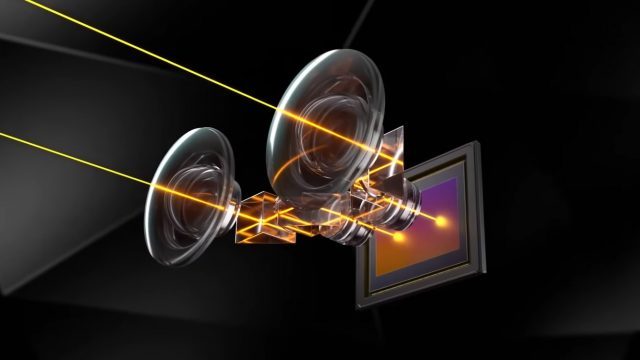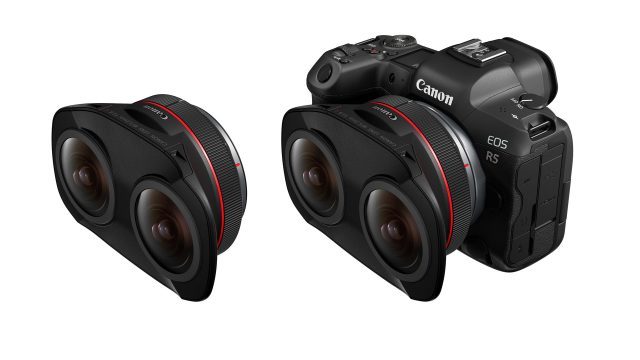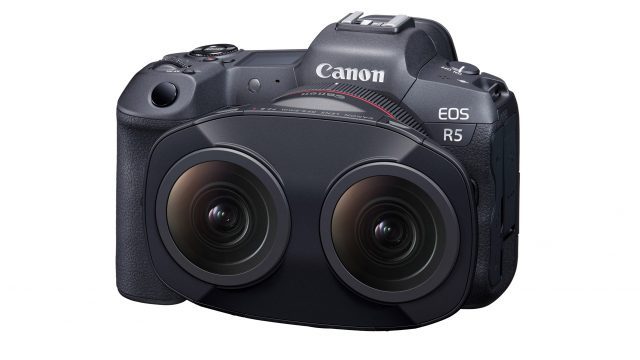Canon, one of the world’s leading camera makers, today introduced a new dual-optic lens which captures 180° stereoscopic views through a single sensor on the company’s high-end EOS R5 camera.
Canon today announced what it calls the EOS VR System which includes its new dual-optic camera lens, new firmware for its EOS R5 camera to support immersive capture, and new software for handling post-processing.
The new RF5.2mm F2.8 L Dual Fisheye lens is interesting because it captures both views onto the single image sensor in the Canon EOS R5 camera. Although this divides the resolution (because both views are captured in the same frame), it also stands to simplify the process of capturing 180° imagery because both views will necessarily have matching time sync, alignment, color, calibration, and focus.

If any of these factors aren’t matched they can have a negative impact on the vieweing experience because it’s uncomfortable for the eyes to reconcile the discrepancies between each view. Capturing this way also means that the output is a single file for both eyes, which can streamline post-production compared to cameras which capture each eye’s view in a separate file (or many views which need to be stitched together).

The lens has an aperture of f/2.8 to f/16 and can be focused as close as 8-inches. The distance between the lenses is fixed at 60mm to be close to the typical human IPD. The company plans to update its Canon Connect and EOS Utility programs to offer a remote live-view through the lens for monitoring and shooting at a distance. Canon says the lens will be available in late December and priced at $2,000.
Around that time the company will also release two pieces of subscription-based software, an EOS VR Utility and EOS VR plug-in for Adobe Premiere Pro.
The EOS VR Utility will be able to convert the captured files from dual-fisheye to an equirectangular projection (which is supported by most immersive video players), as well as make “quick edits” and choose the resolution and file format before exporting.
The EOS VR plug-in for Premiere Pro will enable equirectangular conversion right inside of Premiere and allow the footage to be easily managed within other Adobe Creative Cloud apps.
The company has yet to announce pricing for either utility.

Canon calls the new lens “an important milestone in our company’s rich history as a lens manufacturer,” and says it “welcomes a bright future for VR content creation.”
“This new RF lens produces a stunning 8K virtual reality image and sets itself apart through its simplified workflow. Our goal is to make immersive storytelling more accessible for all,” says Tatsuro “Tony” Kano, EVP and GM of Canon Imaging Technologies & Communications Group.
Live-action immersive video was thought by many to be the next-generation of filmmaking to in the early days of modern VR, but it hasn’t seen nearly as much traction as pre-rendered CGI or real-time rendered content. Complicated immersive camera systems surely didn’t help, and to that end, Canon hopes its new lens and software tools can make a difference.
However, most live-action immersive video also lacks volumetric capture, which means the view can rotate (3DOF) but can’t also move through 3D space (6DOF), which tends to be less comfortable and immersive than VR content which can. Several companies have been working toward volumetric live-action capture, but several key players—like Lytro and NextVR—ultimately didn’t survive and were sold off before finding a market fit.
Whether or not simplified capture and production pipelines are enough to reboot 3DOF live-action immersive content remains to be seen.
In addition to its new lens, Canon has also experimented with XR headsets, most recently the MREAL S1 which it showed off earlier this year.






